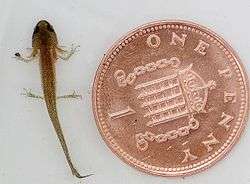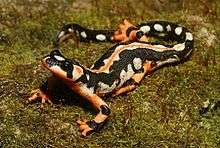Lissotriton
| Lissotriton | |
|---|---|
.jpg) | |
| Lissotriton vulgaris (smooth newt) | |
| Scientific classification | |
| Kingdom: | Animalia |
| Phylum: | Chordata |
| Class: | Amphibia |
| Order: | Caudata |
| Family: | Salamandridae |
| Subfamily: | Pleurodelinae |
| Genus: | Lissotriton Bell, 1839[1] |
| Synonyms | |
|
six[1]
| |
Lissotriton is a genus of newts native to Europe and parts of Asia Minor. As most other newts, they are aquatic as larvae and during breeding time but live in terrestrial, humid habitats over the rest of the season.
These rather small species used to be included in genus Triturus, but phylogenetic analyses demonstrated that genus as paraphyletic.[1][2] In the following, the name Lissotriton, originally introduced by Thomas Bell in 1839, was reinstated for the small-bodied species related to the type species Lissotriton vulgaris (the smooth newt).[1][3]
Their exact phylogenetic placement within the newts (subfamily Pleurodelinae) is still uncertain.[1]
Species
Currently, ten species are listed in Amphibian species of the world[1] – the rank of some of these as species or subspecies is however controversial:
- Lissotriton boscai (Lataste, 1879) – Bosca's newt
- Lissotriton graecus (Wolterstorff, 1906) – Greek newt
- Lissotriton helveticus (Razoumovsky, 1789) – Palmate newt
- Lissotriton italicus (Peracca, 1898) – Italian newt
- Lissotriton kosswigi (Freytag, 1955)
- Lissotriton lantzi (Wolterstorff, 1914) – Caucasian smooth newt
- Lissotriton maltzani (Boettger, 1879)
- Lissotriton meridionalis (Boulenger, 1882) – Southern smooth newt
- Lissotriton montandoni (Boulenger, 1880) – Carpathian newt
- Lissotriton vulgaris (Linnaeus, 1758) – Smooth newt
Gallery
|
Mate selection
Female mate choice is an important concept in evolutionary biology because it bears on female and male reproductive success. Experiments were carried out with Lissotriton vulgarus in which female newts were paired sequentially with two males having different degrees of genetic relatedness to the female. It was found that the more genetically dissimilar male had a higher paternity share than the less related male.[4] Female choice may reflect an avoidance of inbreeding with related males that could lead to less fit progeny (inbreeding depression).
References
- 1 2 3 4 5 6 Frost DR. (2015). "Lissotriton. Amphibian Species of the World: an Online Reference. Version 6.0". New York, USA: American Museum of Natural History. Retrieved 2015-05-20.
- ↑ Titus, T. A.; Larson, A. (1995). "A molecular phylogenetic perspective on the evolutionary radiation of the salamander family Salamandridae". Systematic Biology. 44 (2): 125–151. doi:10.1093/sysbio/44.2.125. ISSN 1063-5157.
- ↑ García-París M, Monton A, Alonso-Zarazaga MA (2004). "Apéndice 1. Nomenclatura: lista de sinónimos y combinaciones". In García-París M, Montori A, Herrero P. Amphibia: Lissamphibia. Fauna Iberica (in Spanish). 24. Madrid: Museo Nacional de Ciencias Naturales and Consejo Superior de Investigaciones Científicas. pp. 589–602. ISBN 978-84-00-08292-5.
- ↑ Jehle R, Sztatecsny M, Wolf JB, Whitlock A, Hödl W, Burke T (2007). "Genetic dissimilarity predicts paternity in the smooth newt (Lissotriton vulgaris)". Biol. Lett. 3 (5): 526–8. doi:10.1098/rsbl.2007.0311. PMC 2391198
 . PMID 17638673.
. PMID 17638673.
External links
| Wikispecies has information related to: Lissotriton |
| Wikimedia Commons has media related to Lissotriton. |


